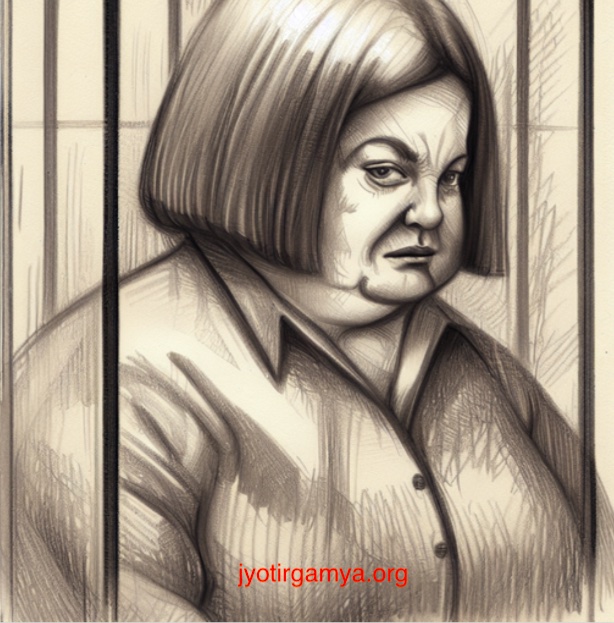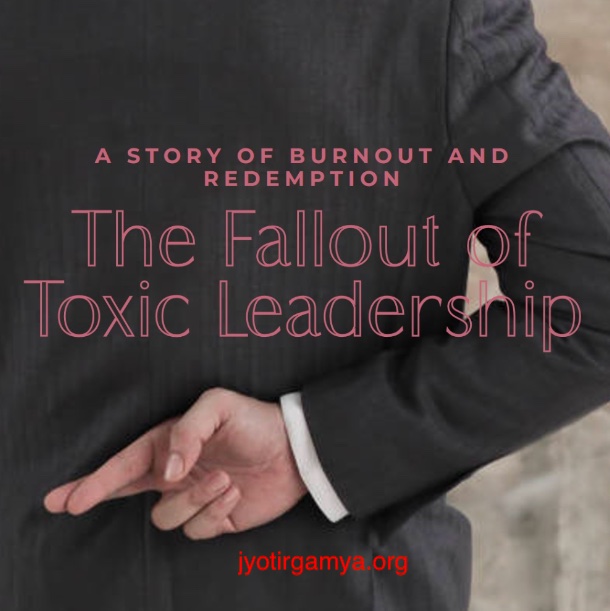The Fallout of Toxic Leadership: A Story of Burnout and Redemption
The scorching sun beat down on the dusty streets of Bullsville, a small village that had only recently been introduced to the world of computers and the internet. The most affluent lady in the village, Samantha, had once ruled over the town with an iron fist, using her cunning and sadistic ways to dominate those around her. But now, she was confined behind bars, her once sharp mind dulled by the weight of her regrets.

As she gazed out at the grey walls around her, she could hear the murmurs of the other inmates echoing through the halls. They knew what she had done, and none were sympathetic to her plight.
One woman in particular, a tough-looking inmate with a scar across her cheek, sauntered over to Samantha’s cell. “What did you do to land yourself here, sweetheart?” she asked with a sneer.
Samantha swallowed hard, knowing there was no point in denying the truth. “I let my jealousy and vindictiveness get the best of me,” she admitted. “I hurt people, and now I’m paying the price.”
The woman shook her head in disgust. “You’re lucky you’re in here and not out there,” she said, gesturing to the outside world beyond the prison walls. “People like you don’t belong with the rest of us out there.”
As the woman walked away, Samantha couldn’t help but feel a pang of regret. She had been so consumed with the desire to dominate those around her that she had lost sight of what mattered.
And as she sat there, reflecting on her mistakes, she knew she had a long road ahead of her if she ever hoped to make amends.
It all started when David, a hard-working and honest young man, joined Samantha’s company as a junior apprentice. He was smart, intelligent, and eager to learn. But Samantha saw him as nothing more than a pawn to be manipulated and enslaved.
In the early days of his apprenticeship, David was eager to learn from Samantha, and he worked hard to prove himself. Samantha would often take advantage of it.

“David, dear, I’m going to need you to stay late tonight,” Samantha would say sweetly, her eyes flashing with malice as she assigned a data-entry task. “I’m counting on you to get this done.”
David would take up the work, but when David would protest, pointing out that he had already worked a full day and was exhausted, Samantha would turn on the charm. “Oh, I know, darling,” she would say with a sly smile. “But think of all the wonderful things we can achieve if we just put in a little extra effort.”
As David worked under Samantha, he found himself constantly stifled and curbed in his initiatives. Samantha would often take credit for his work and belittle him, causing him to feel frustrated and powerless. This led to him experiencing burnout, feeling exhausted and overwhelmed by his job’s constant pressure and demands.
As a result, David began to feel burnt out. He constantly worked under pressure and had little room to breathe or be creative. He felt like he was constantly walking on eggshells around Samantha, never sure when she would lash out at him next.
“I can’t do this anymore,” David said one day, feeling defeated. “I can’t keep working like this. I need to find a way out.”
And so he quit his job and joined another business, hoping to leave Samantha’s toxic influence behind. But Samantha was not one to let things go so quickly. She commissioned hackers to obtain all of David’s information, hoping to take him down once and for all.
She obtained all information about his new job, and used her influence to get him out of the job. David tried to find another, and she would repeat her actions to twist his arm so he’d buckle under pressure and mend his ways.
David kept working hard, but the toll on David’s mental health could not be ignored. He had pushed himself to the brink and needed to step back.
It wasn’t until David learned about Samantha’s dirty tactics that he truly understood the extent of her vindictiveness. Through it all, David persevered. Despite Samantha’s attempts to crush his spirit, he found ways to be creative and innovative.
To deal with his burnout, David prioritized his mental health. He began exercising regularly and doing activities he enjoyed, such as playing music and spending time with loved ones. He also sought the advice of a therapist, who helped him to develop coping mechanisms and strategies for managing stress.
Meanwhile, Samantha’s devious ways caught up with her when one of her employees, who had grown tired of her manipulations, provided David with evidence of her illegal actions.
With the help of the people Samantha had already exploited, David collected all evidence and took her to court. The evidence against Samantha was overwhelming, and her reputation as a businesswoman was shattered.
“I can’t believe he’s doing this to me,” she said, tears streaming down her face as she regaled her staff with tales of betrayal and backstabbing. “After everything I’ve done for them, how could he treat me this way?”
David watched in disbelief as Samantha tried to play the victim card. But he knew better than to fall for her lies.
With this information, David reported Samantha to the authorities, and she was subsequently exposed and thrown behind bars for her crimes.
During this time, he realized he didn’t need to prove anything to Samantha or anyone else. He was proud of who he was and what he had accomplished. With a newfound sense of confidence, he returned to his business and found even more success.

As the sun rose over Bullsville, David looked out at the quiet streets and breathed a sigh of relief. He had overcome the obstacles in his path and emerged victorious. Samantha’s vindictive ways may have once ruled the village, but now it was free from her tyranny. David had shown that honesty, hard work, and determination could triumph over even the most cunning foes.
Her downfall served as a cautionary tale for those who sought to manipulate and harm others for personal gain, and the people of Bullsville rejoiced in knowing that justice had been served.
Introduction
Burnout is a growing problem worldwide, and it can be hard to recognize the warning signs. Feeling more tired than usual, feeling helpless or depressed, and having an unusually negative outlook are some common symptoms. Once you’ve identified that you are suffering from burnout, seeking professional help and identifying the main stressors are crucial first steps. In this article, different experts share their burnout management techniques, which include taking breaks, finding work/life balance, and seeking organizational change. Burnout is an organizational disorder, not a personality disorder, and cultural change is necessary for long-term recovery. Remember that seeking help is a sign of strength, not weakness.

Expert Advice
One of the hardest things is often to recognize that you are in danger of burnout. It sneaks up on us, and then ‘suddenly’ one day, we find ourselves unable to cope. So, looking out for some of the warning signs is vital in managing burnout. But what are the warning signs? These can vary, but generally, they include feeling more tired than usual, even if you are getting enough sleep, feeling helpless, depressed, or having an unusually negative outlook.
Constantly doubting yourself can also be a sign, as can procrastination and feeling overwhelmed. Once you’ve identified that you are suffering from burnout, taking action is important. Seeking professional help can be a significant first step. Identify the main stressors and, if necessary, reduce your workload.
Exercise is vital for our bodies and minds, so get some fresh air outdoors. Don’t forget a healthy diet can do wonders as well. We can’t always take the stressors away, and if that is the case, make sure you plan enough ‘you’ time to do some things that you enjoy, and that will get you out and about. And remember: if you don’t look after yourself, it’s challenging to look after anyone else. There’s nothing selfish about self-care.
The general mantra is to ‘take it easier,’ ‘do less,’ ‘rest more,’ and ‘self-care.’ These are good advice, but only sometimes possible for those with extra professional responsibilities. In my work on this matter - a growing worldwide problem - I prefer to look at each case independently by supporting each client/patient to assess their situation and put issues into context in a way that the person can work with.
A client can divert time and energy for self-care when s/he can find solutions to his/her ongoing difficulties. So my immediate advice would be to seek the support of a professional to talk and think things over in a productive and informed manner, as it is human for our capacity to resolve problems to diminish when we are carrying too much. Seeking help is a sign of strength and not weakness.
“Management should be proactive, encouraging employees to take breaks and vacations and not work long hours. Companies should provide mental health education and benefits.
As for mental health private practitioners or those in business for themselves, self-care is key: take breaks, work reasonable hours, get exercise (I need to exercise more), and find a work/life balance.”
“Burnout management techniques include the following:
-
No contact with clients during nonworking hours(including rescheduling)
-
Communication with other therapists (either informally or through peer supervision
-
Scheduled time for pleasurable activities, including stress management (yoga, etc.)
-
Sense of humor
-
Sense of humility
-
Scheduled time with family/friends.”
“My experience is with emergency service workers. Interestingly, burnout looks a lot like PTSD and considering many emergency service workers have been exposed to high impact events, burnout is often misdiagnosed as PTSD.
The result is a hyper focus on personal factors relating to specific incidents and not enough attention for the workload and low-support factors that cause the distress of burnout.
In my opinion, while the distress of burnout is personal, I frame burnout as an organisational disorder rather than personal disorder.
When the systemic organisational and operational factors highlighted (by those experiencing burnout distress) are listened to, and real strategies are developed to change those systemic failures, burnout distress then lessens and people heal.
Long-term recovery requires cultural change. Leadership development together with necessary business development that adequately resources staff to deliver the purpose of the organisation.
This includes well designed wellbeing systems that supports both staff and families as staff manage the distress of burnout.”
Conclusion
In conclusion, burnout is a severe issue that affects many individuals worldwide, and it can be hard to manage without support. The warning signs can be challenging to identify, but feeling more tired than usual, feeling helpless or depressed, and having an unusually negative outlook are some common symptoms.
Seeking help is a sign of strength, not weakness, and it’s essential to take care of yourself to take care of others.
If you think someone would benefit from the article, please do share it with them.
Want to stay connected? Here’s our twitter.
Related Articles :